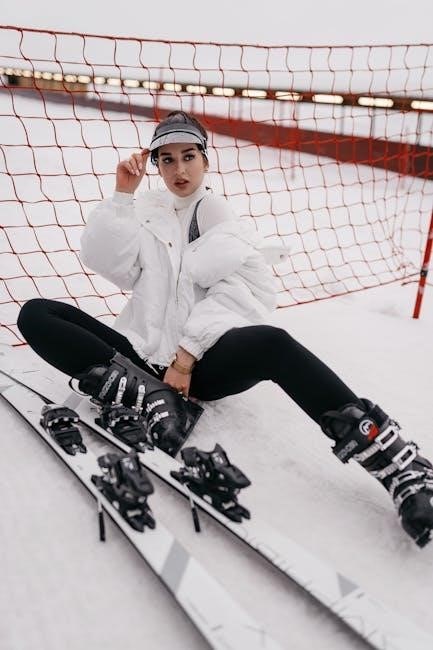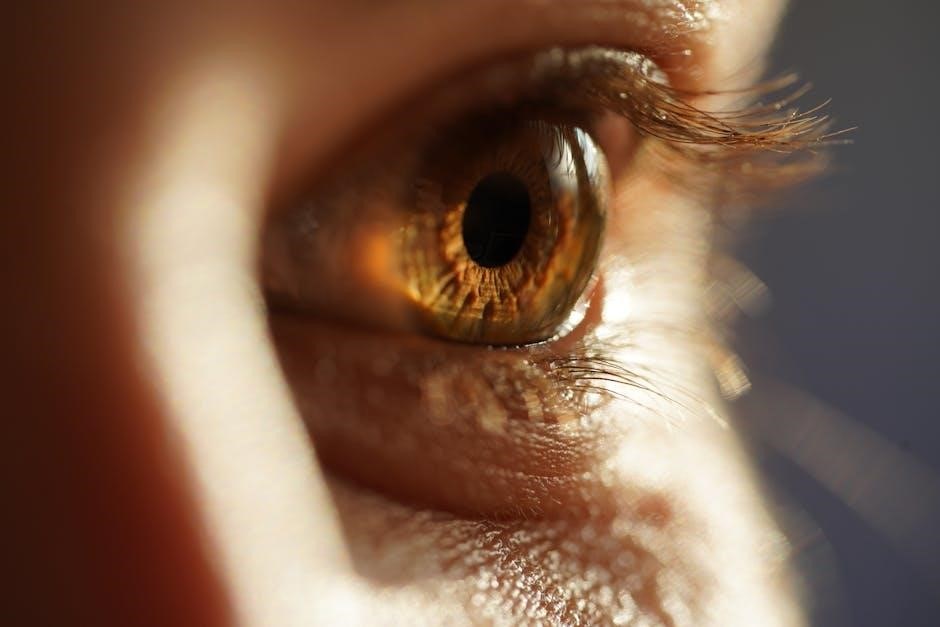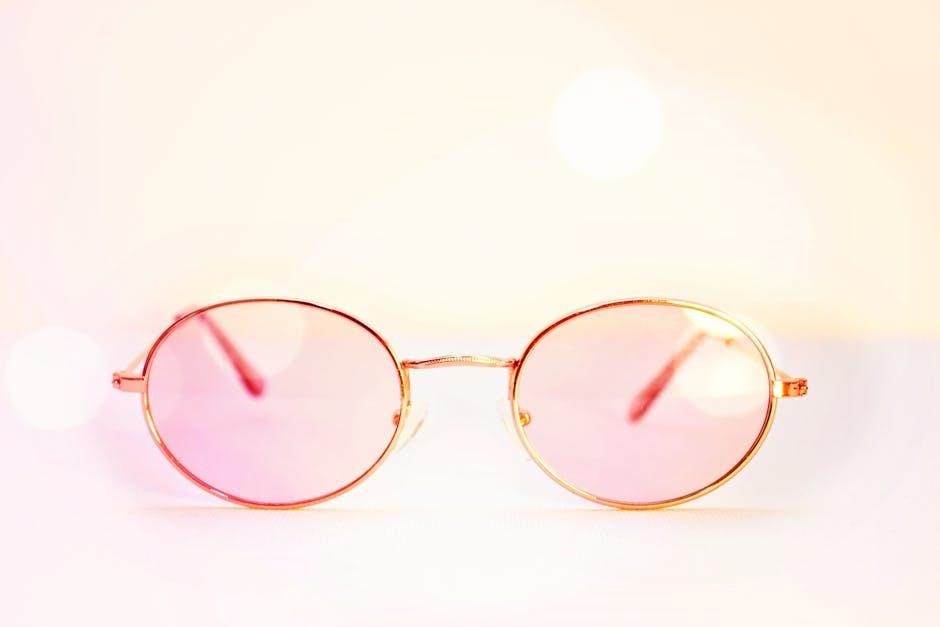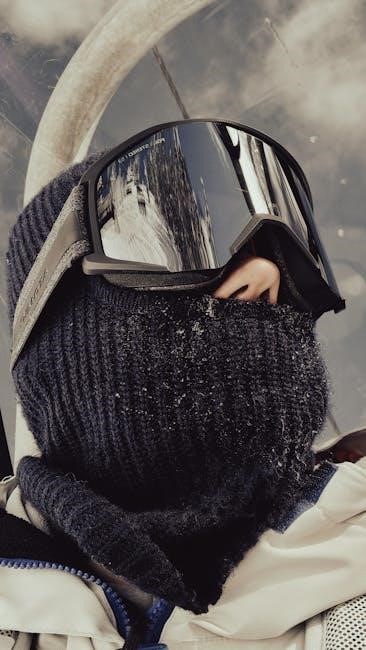Choosing the right lens color for ski goggles is crucial for optimizing vision in various snow conditions. The correct tint enhances clarity‚ reduces glare‚ and protects eyes effectively.

Understanding VLT (Visible Light Transmission)
VLT measures the percentage of visible light transmitted through a lens. Higher VLT allows more light‚ ideal for low-light conditions‚ while lower VLT reduces glare in bright settings.
What is VLT?
VLT stands for Visible Light Transmission‚ which measures the percentage of light that passes through a lens. Higher VLT means more light is transmitted‚ improving visibility in low-light conditions‚ while lower VLT reduces glare and is better suited for bright environments. Many factors‚ including lens color and mirror coatings‚ influence VLT. For example‚ clear lenses typically have a high VLT‚ around 90%‚ making them ideal for night skiing or cloudy days; On the other hand‚ dark-tinted lenses with lower VLT‚ such as 10-20%‚ are designed to protect eyes in sunny conditions by reducing brightness and minimizing glare. Understanding VLT helps skiers choose the right lens for their specific needs‚ ensuring optimal vision and comfort on the slopes. Proper VLT selection can enhance performance and safety‚ making it a critical consideration when selecting ski goggles.
Why is VLT important for Ski Goggles?
VLT (Visible Light Transmission) is crucial for ski goggles as it determines how much light reaches the eyes. High VLT allows more light‚ enhancing visibility in low-light conditions like cloudy days or night skiing. Conversely‚ low VLT reduces light transmission‚ minimizing glare in bright environments‚ such as sunny slopes. Proper VLT selection helps skiers adapt to changing light conditions‚ ensuring optimal vision and comfort. Balancing VLT is essential for managing glare and maintaining clear vision‚ which is vital for safety and performance on the snow. By controlling light transmission‚ VLT plays a key role in enhancing the skiing experience by providing the right amount of light for various conditions.

Popular Lens Colors for Ski Goggles
Ski goggles feature a variety of lens colors‚ including clear‚ yellow‚ amber‚ rose‚ copper‚ bronze‚ blue‚ green‚ purple‚ red‚ and mirror-coated options‚ each tailored for specific conditions.
Clear Lenses
Clear lenses are ideal for low-light conditions‚ such as night skiing or cloudy days‚ as they allow the maximum amount of light to pass through. With a high VLT (Visible Light Transmission) of around 90-100%‚ they provide excellent visibility in poor lighting. These lenses are perfect for maintaining natural color perception and are often used by skiers who prefer minimal tint. However‚ they offer limited UV protection and no glare reduction‚ making them less suitable for sunny conditions. Clear lenses are a practical choice for skiers who prioritize unaltered vision in low-light environments. They are lightweight and versatile‚ ensuring clarity without compromising on comfort. For those who ski primarily in overcast or nighttime settings‚ clear lenses are an excellent option.
Yellow and Amber Lenses
Yellow and amber lenses are excellent for enhancing contrast and improving visibility in flat light or overcast conditions. Their moderate VLT (around 60-70%) allows sufficient light transmission while reducing glare. These tints are particularly effective in snowy environments‚ as they help skiers distinguish between snow textures and depth. Yellow lenses are known to boost visual clarity‚ making them ideal for skiers with sensitive eyes or those navigating low-contrast settings. Amber lenses‚ with a slightly warmer tone‚ offer similar benefits while adding a touch of color enhancement. Both options are versatile and perform well in a variety of lighting conditions‚ making them a popular choice for skiers who frequently encounter changing weather. Their ability to enhance contrast ensures better reaction times and safer navigation on the slopes.
Rose and Pink Lenses
Rose and pink lenses are favored for their ability to enhance contrast and reduce eye strain in varying light conditions. With a VLT range of 50-70%‚ these tints strike a balance between allowing sufficient light and minimizing glare. They are particularly effective in flat light and overcast skies‚ where they help skiers distinguish subtle changes in snow texture and depth. The soft‚ warm tones of rose and pink lenses can improve visual acuity and reduce fatigue‚ making them ideal for skiers who spend extended periods on the slopes. Additionally‚ these lenses are known to enhance color perception‚ providing a clearer and more vivid view of the surroundings. Their versatility and comfort make rose and pink lenses a popular choice among skiers seeking optimal performance without sacrificing style. They are suitable for a wide range of conditions‚ from low light to moderately sunny days.
Copper and Bronze Lenses
Copper and bronze lenses are excellent for enhancing contrast and improving visual clarity‚ particularly in bright to medium light conditions. With a VLT range of 20-40%‚ these tints effectively reduce glare and amplify definition‚ making them ideal for sunny days on the slopes. The warm‚ earthy tones of copper and bronze lenses help skiers better distinguish terrain features‚ such as bumps and moguls‚ by enhancing the visibility of shadows and highlights. These lenses are also known to reduce eye strain caused by harsh light reflections off snow. Their ability to maintain color accuracy ensures a natural view‚ which is beneficial for assessing snow conditions. Copper and bronze lenses are a top choice for skiers who prioritize sharp vision and comfort in a variety of lighting environments‚ making them a versatile option for everyday use.
Blue and Green Lenses
Blue and green lenses are designed to enhance contrast and provide excellent glare reduction‚ making them ideal for bright‚ sunny conditions. With a VLT range of 20-30%‚ these tints are well-suited for skiers who spend most of their time in strong sunlight. The blue and green hues help to neutralize harsh light reflections from snow‚ improving visual clarity and reducing eye strain. These lenses are particularly effective at enhancing the perception of depth and contour‚ which is beneficial for navigating varied terrain. Additionally‚ blue and green tints often create a cooler‚ more vibrant visual experience‚ appealing to those who prefer a distinct aesthetic. While they excel in bright conditions‚ they may not perform as well in low-light environments‚ making them a seasonal choice for specific skiing scenarios. Their ability to balance functionality and style makes them a popular option among skiers.
Purple and Red Lenses
Purple and red lenses are less common but offer unique benefits for specific skiing conditions. These tints are designed to enhance certain wavelengths of light‚ improving visibility in flat or overcast conditions by amplifying contrast and reducing haze; With a moderate VLT of 30-40%‚ they strike a balance between light transmission and protection‚ making them suitable for intermediate lighting environments. Purple lenses‚ in particular‚ are favored for their ability to enhance depth perception and reduce eye fatigue‚ while red lenses can heighten color contrast‚ making snow textures more defined. These lenses are ideal for skiers who frequently encounter changing light conditions or prefer a vibrant‚ enhanced visual experience. However‚ they may not perform as well in extremely bright or low-light settings‚ making them a niche choice tailored to specific needs.
Mirror Coatings
Mirror coatings add a reflective layer to ski goggle lenses‚ offering enhanced style and functionality. These coatings reduce glare by reflecting a portion of incoming light‚ thus lowering overall VLT slightly. Available in various colors like silver‚ gold‚ and blue‚ they not only improve visual comfort in bright conditions but also protect eyes from harmful UV rays. Mirror coatings are particularly beneficial for skiers in sunny environments or those exposed to high levels of reflective light from snow. While they don’t affect the lens color itself‚ they enhance performance by minimizing glare and reducing eye strain. However‚ mirror coatings may not be ideal for low-light conditions‚ as they can further limit light transmission. They remain a popular choice for balancing aesthetics and performance in bright settings.

Best Lens Colors for Specific Conditions
Low light: Clear or amber lenses for maximum VLT. Flat light: Rose or yellow for enhanced contrast. Bright conditions: Darker tints like copper or bronze. Snowy/icy: Mirror coatings reduce glare.
Low Light Conditions
In low-light conditions‚ such as skiing at dawn‚ dusk‚ or under cloudy skies‚ clear or amber lenses are ideal. These tints maximize visible light transmission (VLT)‚ ensuring better visibility and reducing eye strain. Clear lenses offer the highest VLT‚ allowing the most natural light to reach your eyes‚ while amber lenses enhance contrast slightly without sacrificing too much light. Avoid darker or mirrored lenses in these situations‚ as they can make it harder to see. For nighttime skiing‚ clear lenses are especially recommended to maintain clarity in dim environments. Proper lens choice in low-light conditions is essential for safety and performance‚ helping you navigate the slopes with confidence.
Flat Light and Overcast Skies
Flat light and overcast conditions pose unique challenges‚ as the sky and snow blend into a uniform brightness‚ reducing contrast. To combat this‚ opt for lenses with enhanced contrast and minimal VLT. Rose‚ amber‚ or yellow-tinted lenses are excellent choices‚ as they amplify contrast and add warmth‚ making it easier to distinguish contours and textures on the snow. These tints help reduce the flattening effect of overcast skies‚ improving depth perception and reducing eye fatigue. Avoid clear or very dark lenses‚ as they may exacerbate the lack of contrast. Polarized lenses can also help by reducing glare from the snow‚ though they are less common in ski goggles. Proper lens selection in flat light ensures better visibility and safer skiing.
Bright and Sunny Conditions
Bright‚ sunny conditions require lenses that offer maximum protection from intense light and glare. Darker tints‚ such as black‚ gray‚ or mirrored lenses‚ are ideal as they effectively block a higher percentage of visible light‚ reducing eye strain. These lenses also minimize glare from the snow‚ which is amplified in sunny environments. For enhanced performance‚ consider lenses with a mirrored coating‚ as they reflect light and further reduce brightness. Additionally‚ polarized lenses can be beneficial in sunny conditions by eliminating horizontal glare from reflective surfaces like snow. While polarized lenses are less common in ski goggles‚ they provide superior glare reduction. Ultimately‚ darker tints and mirrored coatings are the best choices for maintaining comfort and clarity in bright‚ sunny conditions.
Snowy and Icy Conditions
In snowy and icy conditions‚ visibility can be challenging due to reflected light and flat terrain. Amber‚ rose‚ or yellow lenses are excellent choices as they enhance contrast‚ making it easier to distinguish between snow and ice. These tints also perform well in overcast or flat-light conditions‚ which are common in snowy environments. For icy surfaces‚ mirrored coatings can help reduce glare from the reflective snow‚ improving comfort and reducing eye strain. Additionally‚ lenses with high VLT (around 50-70%) are beneficial‚ as they allow more light to pass through‚ enhancing visibility in low-contrast scenarios. Proper UV protection is also crucial‚ as snow reflects UV rays‚ potentially causing discomfort. Cleaning your lenses regularly is essential to maintain clarity in snowy conditions. Ultimately‚ the right lens color and coating can significantly improve your skiing experience in snowy and icy terrain.

Factors to Consider When Choosing Lens Color
When selecting lens color‚ consider VLT‚ personal eye sensitivity‚ and UV protection. Polarized lenses reduce glare‚ while mirror coatings enhance style and reduce eye strain. Choose wisely for optimal vision.
Personal Preference and Eye Sensitivity
Personal preference and eye sensitivity play significant roles in selecting ski goggle lens colors. Some individuals prefer darker tints for reduced light penetration‚ especially if they have sensitive eyes. Others may opt for lighter tints to maintain visibility in low-light conditions. It’s essential to consider how different colors affect visual comfort and clarity. For instance‚ amber or yellow lenses enhance contrast‚ which can be beneficial for those with sensitivity to flat light. Additionally‚ mirror coatings can reduce glare without altering the visible light transmission (VLT)‚ offering a stylish and functional option. Balancing aesthetics with eye comfort ensures the best performance on the slopes‚ making personal preference a key factor in lens selection.
uv Protection
UV Protection
UV protection is a critical factor when choosing ski goggle lenses‚ as it safeguards your eyes from harmful ultraviolet radiation. Prolonged exposure to UV rays‚ especially at high altitudes or on snowy surfaces where light reflects intensely‚ can lead to conditions like cataracts and snow blindness. All reputable ski goggles provide UV protection‚ blocking 100% of UVA and UVB rays‚ regardless of lens color or tint. This ensures your eyes remain protected even in extreme conditions. It’s important to note that UV protection is not solely dependent on lens darkness; even clear lenses can offer full UV defense. Prioritizing UV protection is essential for long-term eye health and optimal performance on the slopes;
Polarized vs. Non-Polarized Lenses
Polarized lenses are designed to reduce glare from reflective surfaces like snow or ice‚ improving visibility and reducing eye strain. They work by filtering out horizontally polarized light‚ which is commonly reflected off flat surfaces. While polarized lenses can enhance clarity and reduce discomfort caused by glare‚ they may not be as effective in low-light conditions or when depth perception is critical. Non-polarized lenses‚ on the other hand‚ allow more light to pass through‚ making them better suited for cloudy or overcast days. Both options typically offer UV protection‚ ensuring your eyes are safeguarded from harmful sunlight. The choice between polarized and non-polarized lenses depends on the specific skiing conditions and personal preference‚ as neither is inherently superior in all situations.

Care and Maintenance Tips
Regularly clean your lenses with a soft cloth to avoid scratches. Avoid using harsh chemicals or abrasive materials. Store goggles in a protective case to prevent damage. Always handle lenses by the frame to avoid smudging. Replace scratched or worn-out lenses for optimal performance. Keep goggles away from extreme temperatures to maintain their integrity.
Cleaning Your Lenses
Cleaning your ski goggles’ lenses is essential to maintain their performance and longevity. Always use a soft‚ dry microfiber cloth to gently wipe away dirt‚ snow‚ or smudges. Avoid using paper towels or other abrasive materials‚ as they can scratch the lenses or damage any mirror coatings. For more stubborn smudges or fingerprints‚ lightly dampen the cloth with fresh water‚ but never use chemical cleaners‚ alcohol‚ or other harsh substances‚ as these can strip away protective coatings or discolor the tint. Regular cleaning prevents the buildup of grime and ensures optimal visibility on the slopes. Store the cleaning cloth in a protective pouch to keep it clean and ready for use. Consistent care will keep your goggles functioning at their best.
Storing Your Goggles
Proper storage of your ski goggles is essential to maintain their quality and functionality. Always store them in a protective case or pouch to shield the lenses from scratches and damage. Avoid placing goggles in direct sunlight or extreme temperatures‚ as this can cause distortion or discoloration of the lens tints. Before storage‚ ensure the lenses are clean and dry to prevent moisture buildup‚ which can lead to fogging or mold. Use a soft‚ dry microfiber cloth to wipe down the goggles before placing them in their case. Never stack goggles on top of each other‚ as this can cause pressure marks or scratches. By storing your goggles correctly‚ you’ll ensure they remain in prime condition for future skiing adventures.
Replacing Lenses
Replacing lenses in ski goggles is a straightforward process that can extend the life of your eyewear. Start by purchasing replacement lenses that match your goggles’ frame size and model. Refer to the manufacturer’s instructions for specific guidance‚ as some goggles have unique mechanisms. Remove the old lenses by gently pressing the frame’s release points or sliding them out from the sides. Handle the new lenses by the edges to avoid smudging or leaving fingerprints. Insert the new lenses‚ ensuring they click securely into place. Double-check alignment to prevent optical distortion. If unsure‚ consult a professional or the brand’s customer support. Regular lens replacement ensures optimal vision and protects your investment in high-quality goggles.

Selecting the right lens color for your ski goggles significantly enhances your skiing experience by improving visibility and reducing eye strain. With various tints suited for different light conditions‚ understanding VLT and personal preferences ensures optimal performance. Whether tackling low light or bright‚ sunny slopes‚ the right lens color boosts clarity and safety. Additionally‚ proper care and maintenance extend the life of your goggles. By considering UV protection‚ polarization‚ and storage practices‚ you can make informed decisions tailored to your needs. Invest time in choosing the perfect lenses‚ and enjoy unparalleled vision on the mountain‚ ensuring every ski trip is memorable and enjoyable.

